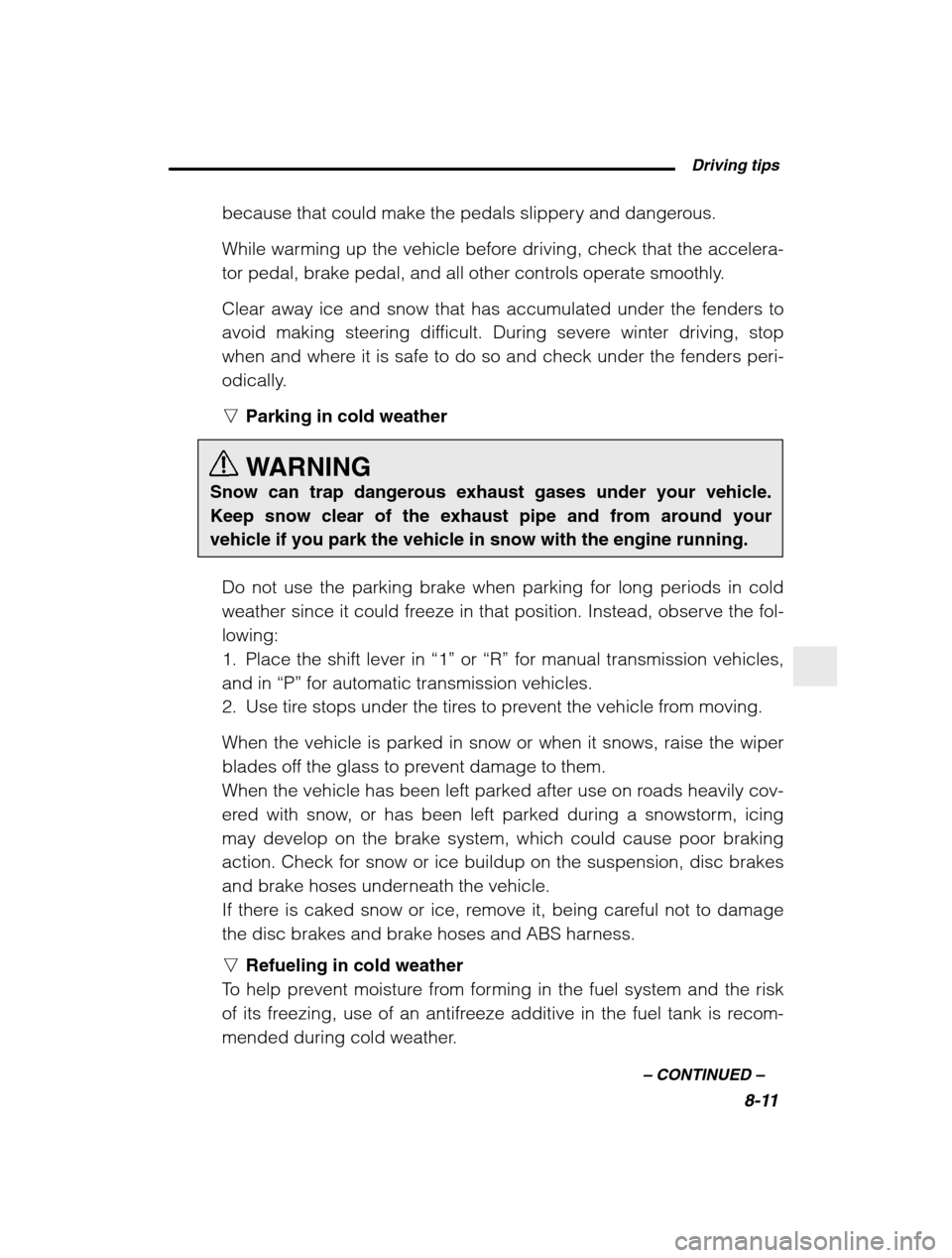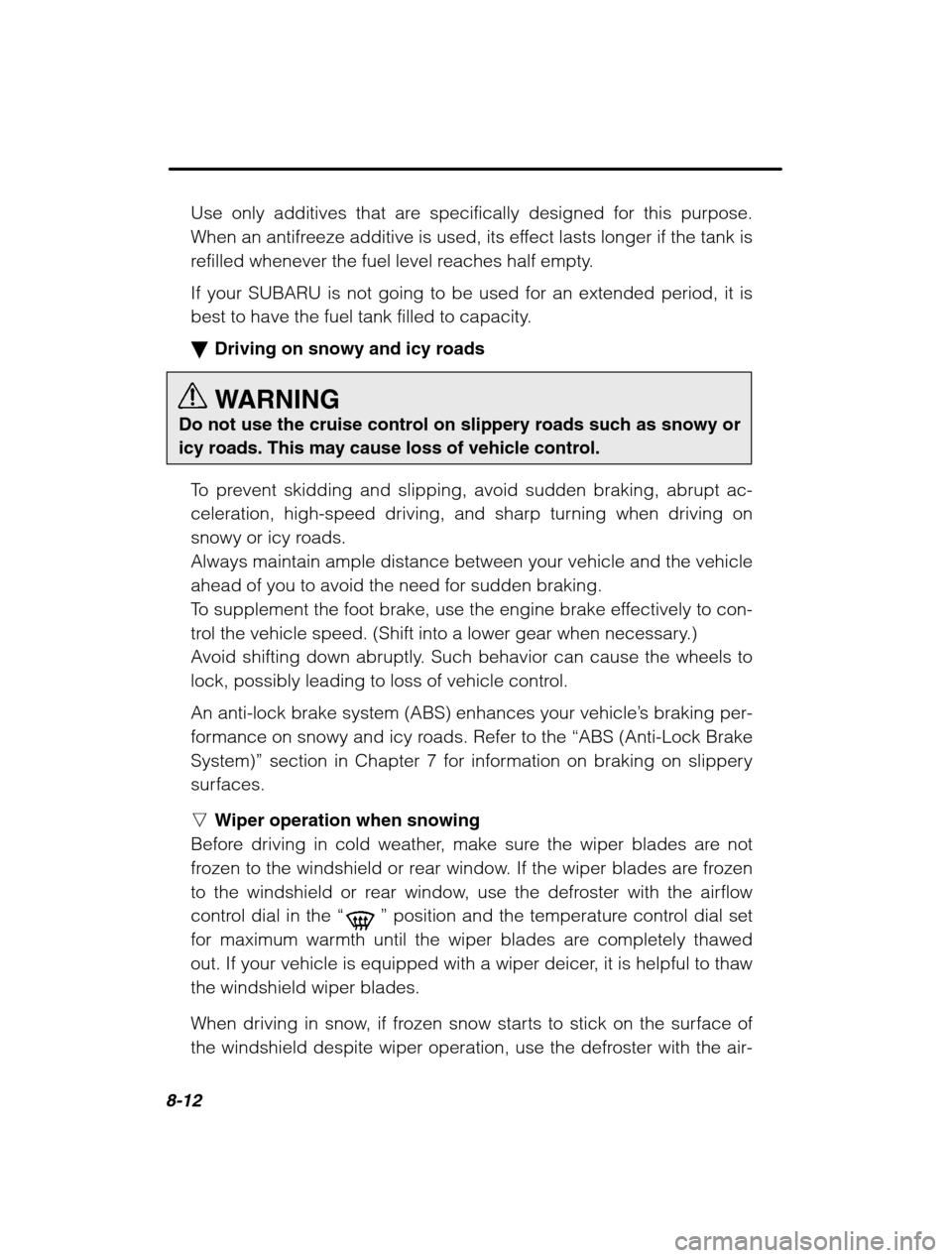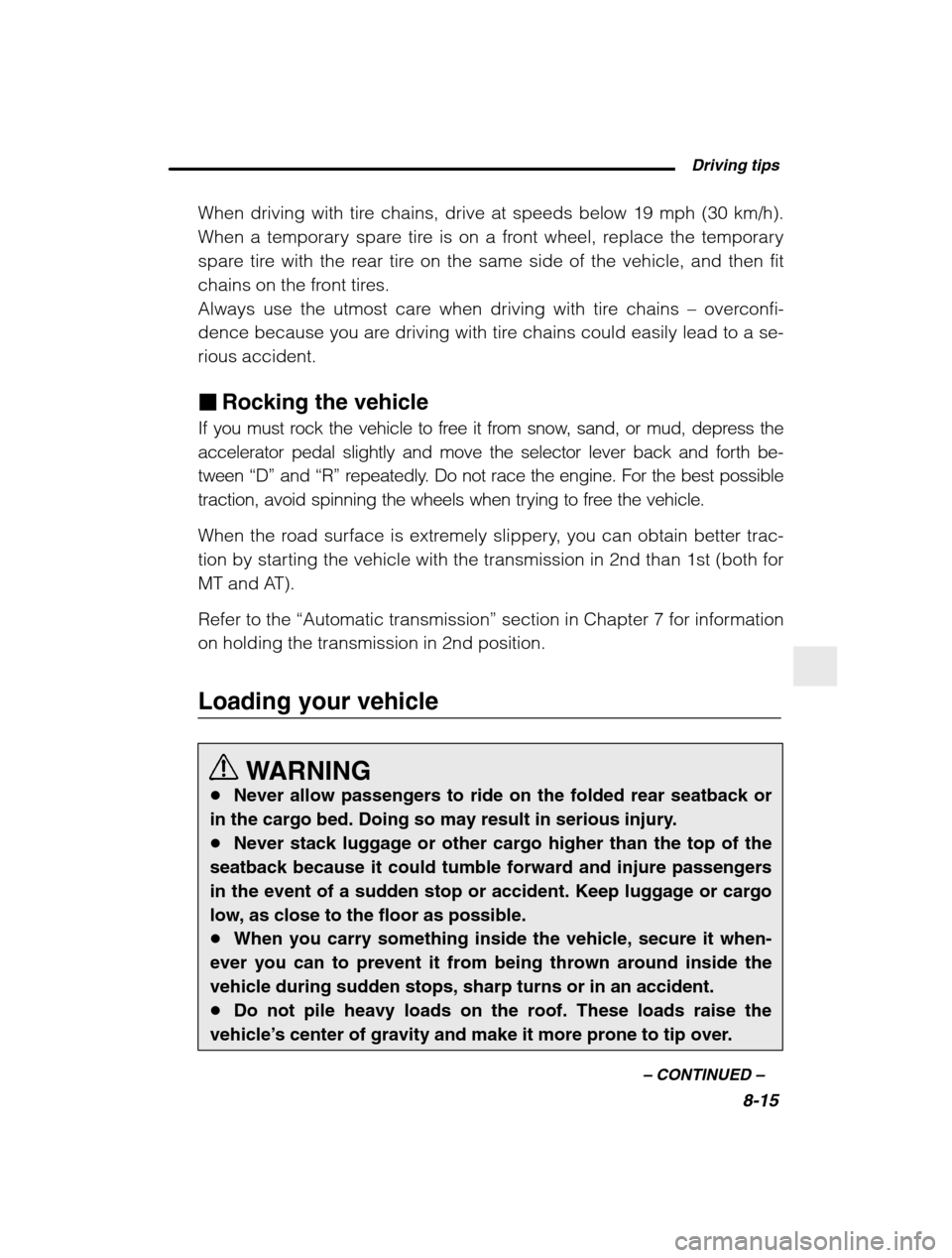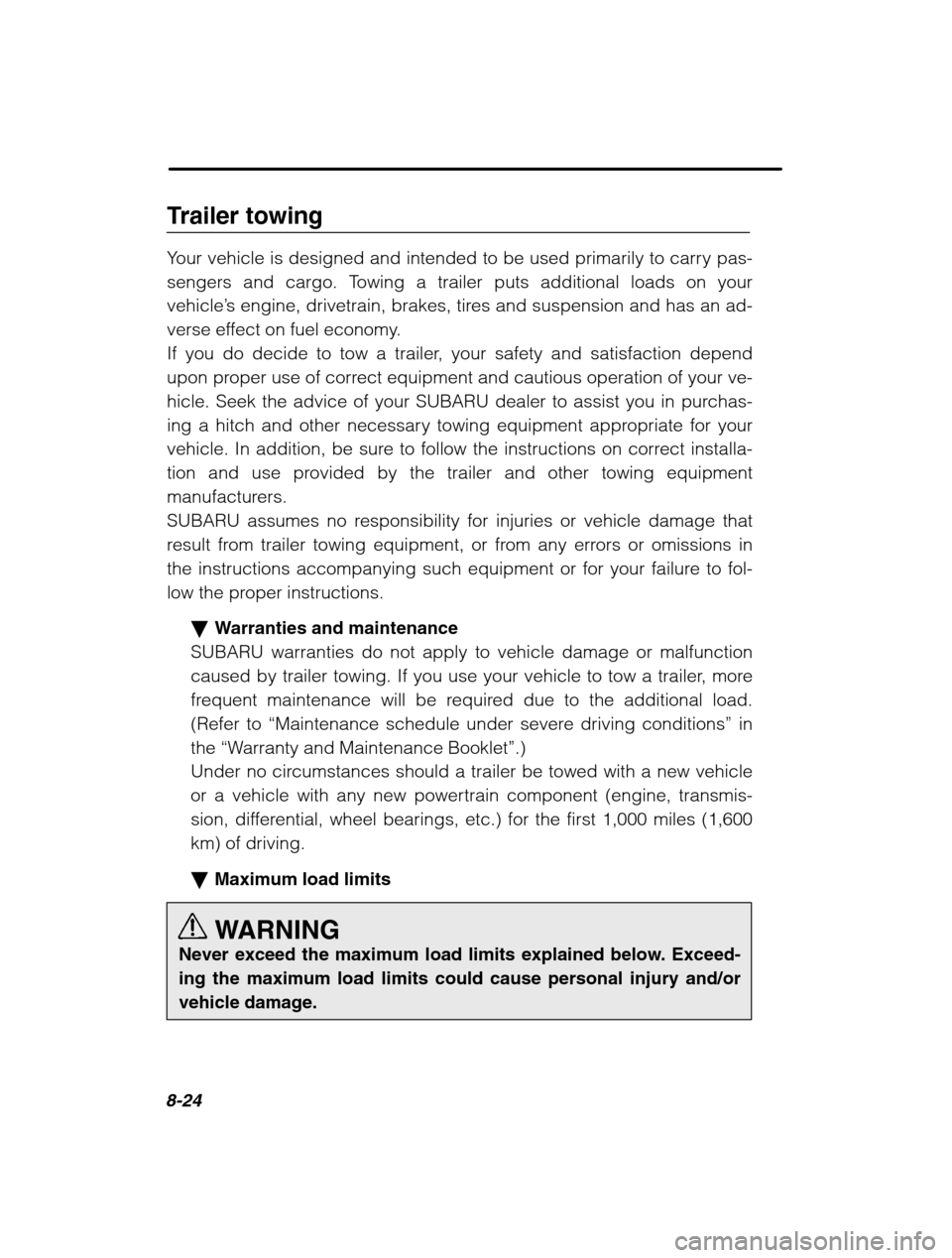2003 SUBARU BAJA engine
[x] Cancel search: enginePage 249 of 400

Driving tips8-11
–
CONTINUED –
because that could make the pedals slippery and dangerous.
While warming up the vehicle before driving, check that the accelera-
tor pedal, brake pedal, and all other controls operate smoothly.
Clear away ice and snow that has accumulated under the fenders to
avoid making steering difficult. During severe winter driving, stop
when and where it is safe to do so and check under the fenders peri-
odically. nParking in cold weather
WARNING
Snow can trap dangerous exhaust gases under your vehicle. Keep snow clear of the exhaust pipe and from around your
vehicle if you park the vehicle in snow with the engine running.
Do not use the parking brake when parking for long periods in cold
weather since it could freeze in that position. Instead, observe the fol-lowing:
1. Place the shift lever in “1” or “R” for manual transmission vehicles,
and in “P” for automatic transmission vehicles.
2. Use tire stops under the tires to prevent the vehicle from moving.
When the vehicle is parked in snow or when it snows, raise the wiper
blades off the glass to prevent damage to them.
When the vehicle has been left parked after use on roads heavily cov-
ered with snow, or has been left parked during a snowstorm, icingmay develop on the brake system, which could cause poor braking
action. Check for snow or ice buildup on the suspension, disc brakes
and brake hoses underneath the vehicle.
If there is caked snow or ice, remove it, being careful not to damage
the disc brakes and brake hoses and ABS harness. n Refueling in cold weather
To help prevent moisture from forming in the fuel system and the risk
of its freezing, use of an antifreeze additive in the fuel tank is recom-
mended during cold weather.
Page 250 of 400

8-12
Use only additives that are specifically designed for this purpose.
When an antifreeze additive is used, its effect lasts longer if the tank is
refilled whenever the fuel level reaches half empty. If your SUBARU is not going to be used for an extended period, it is
best to have the fuel tank filled to capacity. �Driving on snowy and icy roads
WARNING
Do not use the cruise control on slippery roads such as snowy or icy roads. This may cause loss of vehicle control.
To prevent skidding and slipping, avoid sudden braking, abrupt ac-
celeration, high-speed driving, and sharp turning when driving on
snowy or icy roads.Always maintain ample distance between your vehicle and the vehicleahead of you to avoid the need for sudden braking.
To supplement the foot brake, use the engine brake effectively to con-
trol the vehicle speed. (Shift into a lower gear when necessary.)
Avoid shifting down abruptly. Such behavior can cause the wheels to
lock, possibly leading to loss of vehicle control.
An anti-lock brake system (ABS) enhances your vehicle ’s braking per-
formance on snowy and icy roads. Refer to the “ABS (Anti-Lock Brake
System)” section in Chapter 7 for information on braking on slippery
surfaces. n Wiper operation when snowing
Before driving in cold weather, make sure the wiper blades are not
frozen to the windshield or rear window. If the wiper blades are frozen
to the windshield or rear window, use the defroster with the airflow
control dial in the “
” position and the temperature control dial set
for maximum warmth until the wiper blades are completely thawed
out. If your vehicle is equipped with a wiper deicer, it is helpful to thawthe windshield wiper blades.
When driving in snow, if frozen snow starts to stick on the surface of
the windshield despite wiper operation, use the defroster with the air-
Page 253 of 400

Driving tips8-15
–
CONTINUED –
When driving with tire chains, drive at speeds below 19 mph (30 km/h).
When a temporary spare tire is on a front wheel, replace the temporary
spare tire with the rear tire on the same side of the vehicle, and then fit
chains on the front tires.
Always use the utmost care when driving with tire chains – overconfi-
dence because you are driving with tire chains could easily lead to a se-rious accident. � Rocking the vehicle
If you must rock the vehicle to free it from snow, sand, or mud, depress the
accelerator pedal slightly and move the selector lever back and forth be-
tween “D” and “R” repeatedly. Do not race the engine. For the best possible
traction, avoid spinning the wheels when trying to free the vehicle.
When the road surface is extremely slippery, you can obtain better trac-
tion by starting the vehicle with the transmission in 2nd than 1st (both for
MT and AT). Refer to the “Automatic transmission ” section in Chapter 7 for information
on holding the transmission in 2nd position.
Loading your vehicle
WARNING
� Never allow passengers to ride on the folded rear seatback or
in the cargo bed. Doing so may result in serious injury. � Never stack luggage or other cargo higher than the top of the
seatback because it could tumble forward and injure passengersin the event of a sudden stop or accident. Keep luggage or cargo
low, as close to the floor as possible. � When you carry something inside the vehicle, secure it when-
ever you can to prevent it from being thrown around inside the
vehicle during sudden stops, sharp turns or in an accident.� Do not pile heavy loads on the roof. These loads raise the
vehicle’ s center of gravity and make it more prone to tip over.
Page 262 of 400

8-24
Trailer towing
Your vehicle is designed and intended to be used primarily to carry pas-
sengers and cargo. Towing a trailer puts additional loads on your
vehicle’s engine, drivetrain, brakes, tires and suspension and has an ad-
verse effect on fuel economy.
If you do decide to tow a trailer, your safety and satisfaction depend
upon proper use of correct equipment and cautious operation of your ve-
hicle. Seek the advice of your SUBARU dealer to assist you in purchas-
ing a hitch and other necessary towing equipment appropriate for your
vehicle. In addition, be sure to follow the instructions on correct installa-
tion and use provided by the trailer and other towing equipment
manufacturers.
SUBARU assumes no responsibility for injuries or vehicle damage that
result from trailer towing equipment, or from any errors or omissions in
the instructions accompanying such equipment or for your failure to fol-
low the proper instructions.
�Warranties and maintenance
SUBARU warranties do not apply to vehicle damage or malfunction
caused by trailer towing. If you use your vehicle to tow a trailer, more
frequent maintenance will be required due to the additional load.(Refer to “Maintenance schedule under severe driving conditions ” in
the “Warranty and Maintenance Booklet ”.)
Under no circumstances should a trailer be towed with a new vehicle
or a vehicle with any new powertrain component (engine, transmis-
sion, differential, wheel bearings, etc.) for the first 1,000 miles (1,600km) of driving. � Maximum load limits
WARNING
Never exceed the maximum load limits explained below. Exceed- ing the maximum load limits could cause personal injury and/or
vehicle damage.
Page 271 of 400

Driving tips8-33
–
CONTINUED –
nBefore starting out on a trip
� Check that the vehicle and vehicle-to-hitch mounting are in good
condition. If any problems are apparent, do not tow the trailer. � Check that the vehicle sits horizontally with the trailer attached. If
the vehicle is tipped sharply up at the front and down at the rear,
check the total trailer weight, GVW, GAWs and tongue load again,
then confirm that the load and its distribution are acceptable.� Check that the tire pressures are correct.
� Check that the vehicle and trailer are connected properly. Confirm
that. – the trailer tongue is connected properly to the hitch ball.
– the trailer lights connector is connected properly and trailer ’s
brake lights illuminate when the vehicle ’s brake pedal is pressed,
and that the trailer ’s turn signal lights flash when the vehicle ’s turn
signal lever is operated.– the safety chains are connected properly.
– all cargo in the trailer is secured safety in position.
– the side mirrors provide a good rearward field of view without a
significant blind spot.
� Sufficient time should be taken to learn the “feel” of the vehicle/
trailer combination before starting out on a trip. In an area free of traf-
fic, practice turning, stopping and backing up. n Driving with a trailer
� You should allow for considerably more stopping distance when
towing a trailer. Avoid sudden braking because it may result in skid-
ding or jackknifing and loss of control.� Avoid abrupt starts and sudden accelerations. If your vehicle has a
manual transmission, always start out in first gear and release the
clutch at moderate engine revolution.� Avoid uneven steering, sharp turns and rapid lane changes.
� Slow down before turning. Make a longer than normal turning
radius because the trailer wheels will be closer than the vehicle
wheels to the inside of the turn. In a tight turn, the trailer could hit yourvehicle.� Crosswinds will adversely affect the handling of your vehicle and
Page 272 of 400

8-34
trailer, causing sway. Crosswinds can be due to weather conditions or
the passing of large trucks or buses. If swaying occurs, firmly grip the
steering wheel and slow down immediately but gradually.�When passing other vehicles, considerable distance is required
because of the added weight and length caused by attaching the
trailer to your vehicle.� Backing up with a trailer is difficult and takes practice. When back-
ing up with a trailer, never accelerate or steer rapidly. When turning
back, grip the bottom of the steering wheel with one hand and turn it
to the left for a left turn, and turn it to the right for a right turn.
Left turn Right turn
OM-H2791
� If the ABS warning light illuminates while the vehicle is in motion,
stop towing the trailer and have repairs performed immediately by the
nearest SUBARU dealer. n Driving on grades
� Before going down a steep hill, slow down and shift into lower gear
(if necessary, use 1st gear) in order to utilize the engine braking effect
and prevent overheating of your vehicle ’s brakes. Do not make sud-
den downshifts.� When driving uphill in hot weather, the air conditioner may turn off
automatically to protect the engine from overheating.� When driving uphill in hot weather, pay attention to the water tem-
perature gauge pointer (for all vehicles) and AT OIL TEMP warning
light (for AT vehicles) since the engine and transmission are relatively
prone to overheating under these conditions. If the water temperature
Page 273 of 400

Driving tips8-35
–
CONTINUED –
gauge pointer approaches the OVERHEAT zone or the AT OIL TEMP
warning light illuminates, immediately switch off the air conditioner
and stop the vehicle at the nearest safe place. Refer to the “Engine
overheat” section in Chapter 9, and “Warning and indicator lights ”
section in Chapter 3.� If your vehicle has an automatic transmission, avoid using the
accelerator pedal to stay stationary on an uphill slope instead of usingthe parking brake or foot brake. That may cause the transmission fluidto overheat. Also, if your vehicle is equipped with an automatic trans-mission, avoid driving with the gear selector lever in “D” when towing
a heavy trailer to prevent fluid overheating. A lower gear should beused. n Parking on a grade
Always block the wheels under both vehicle and trailer when parking.
Apply the parking brake firmly. You should not park on a hill or slope.But if parking on a hill or slope cannot be avoided, you should takethe following steps:
1. Apply the brakes and hold the pedal down.
2. Have someone place wheel blocks under both the vehicle and
trailer wheels.
3. When the wheel blocks are in place, release the regular brakes
slowly until the blocks absorb the load.
4. Apply the regular brakes and then apply the parking brake; slowly
release the regular brakes.
5. Shift into 1st or reverse gear (manual transmission) or “P” (auto-
matic transmission) and shut off the engine.
Page 275 of 400

9
In case of emergency
If you park your vehicle in an emergency 9-2. . . . . . . . . . . . . . . . . . . . . . . .
Jack and tools 9-3
. . . . . . . . . . . . . . . . . . . . . . . . . . . . . . . . . . . . . . . . . . . . . . . . . . . . . . . . . . . . .
Spare tire 9-6
. . . . . . . . . . . . . . . . . . . . . . . . . . . . . . . . . . . . . . . . . . . . . . . . . . . . . . . . . . . . . . . . . . . .
Temporary spare tire 9-9
. . . . . . . . . . . . . . . . . . . . . . . . . . . . . . . . . . . . . . . . . . . . . . . . . . . .
Using the temporary spare tire 9-9
. . . . . . . . . . . . . . . . . . . . . . . . . . . . . . . . . . . . . . . .
Flat tires 9-11
. . . . . . . . . . . . . . . . . . . . . . . . . . . . . . . . . . . . . . . . . . . . . . . . . . . . . . . . . . . . . . . . . . . . . .
Changing a flat tire 9-11
. . . . . . . . . . . . . . . . . . . . . . . . . . . . . . . . . . . . . . . . . . . . . . . . . . . . . .
Jump starting 9-18
. . . . . . . . . . . . . . . . . . . . . . . . . . . . . . . . . . . . . . . . . . . . . . . . . . . . . . . . . . . . . .
Engine overheating 9-21
. . . . . . . . . . . . . . . . . . . . . . . . . . . . . . . . . . . . . . . . . . . . . . . . . . . . . .
Towing 9-22
. . . . . . . . . . . . . . . . . . . . . . . . . . . . . . . . . . . . . . . . . . . . . . . . . . . . . . . . . . . . . . . . . . . . . . . .
Moonroof — if the moonroof cannot be closed 9-27 . . . . . . . . . . . . . . . .